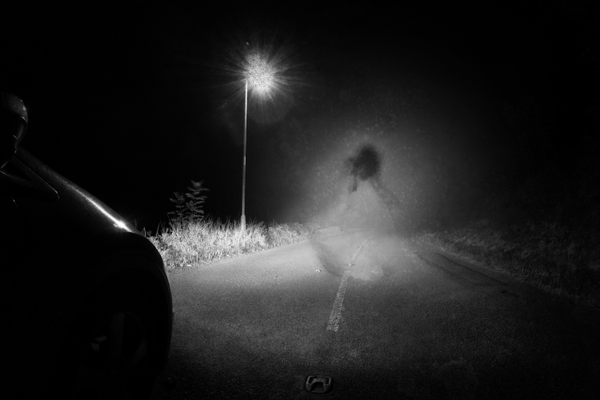Inside the Weird World of Corn Mazes
The a-maize-ing history of getting lost among the stalks.
It was a sunny autumn day in Danvers, Massachusetts on Oct. 10, 2011—perfect for some fall fun. Taking advantage of the good weather, a family of four ventured into a headless horseman-themed corn maze at Connors Farm. Things quickly unraveled. As the sun set and the maze closed for the evening, members of the family, which included a five-year-old child and three-week-old baby, realized getting lost wasn’t as amusing as they thought. Eventually, they called the police department, desperate for a way out.
“We thought this would be fun,” the woman said on the phone with the police, according to a NBC News story about the misadventure. “Instead, it’s a nightmare. I don’t know what made us do this.”
Though stressed, the family was never in any real danger. The maze staff were still on site, waiting for them to finish, and would have gone in to find them if needed. And the family simply could have walked through the corn “walls” to the field edge at any time. But panicked parents and kids aren’t that unusual. Anxious corn maze calls to 911 happen more often than you might think. At Cool Patch Pumpkins in Dixon, California, emergency calls from deep inside their massive, 60-acre corn maze, one of the world’s largest, are an annual occurrence.

Mazes are supposed to be fun—even the getting lost part, says Brett Herbst, who has been designing mazes in Utah and across the country since 1996. Herbst says there’s an art to making a maze: It must be engaging but not so tricky that people quit. “If you make it too challenging, you lose some people,” he says. While some visitors call the cops when they can’t find their way out, the bigger risk is people getting frustrated and cheating, he adds.
People have been experiencing the twists and turns of mazes for millennia, as architectural defenses intended to slow and confuse the enemy, for walking meditations, and yes, as entertainment. Hedge mazes, with dense greenery that towered over players, became popular with European aristocrats in the 17th century, heralding the future fun of the corn maze.
The modern corn maze—in which visitors are usually tasked with finding an exit or solving a variety of challenges—is a fairly recent invention, created only in 1993. Don Frantz, a creative director who had worked on Broadway and the Super Bowl’s halftime show, thought of the idea while admiring cornfields from an airplane. He recruited British designer Adrian Fisher to carve a dinosaur named Cornelius the Cobasaurus into a three-acre Pennsylvania field. Workers pulled stalks by hand to create the design.

The attraction, dubbed “The Amazing Maize Maze,” quickly garnered media attention and inspired farmers around the country to create their own versions. For example, Herbst runs a company—The Maize—that not only crafts an annual maze in Utah, but also helps hundreds of other farms do the same.
While mazes have become more intricate, a lot remains the same from those early days, Herbst says. Corn is typically planted in a grid system, which makes it easy to map out designs using software such as Adobe Illustrator. Then comes the tricky part—actually cutting the maze out. Herbst remembers making his first corn maze using a weed wacker with a saw blade attachment.
For the ideal maze, you want to cut the path when the corn is somewhat grown—about three feet high—but not so tall that falling stalks risk knocking down their neighbors, which creates jagged lines, says maze manager David Wissemann. He and his wife create designs for the family company and farm, Mike’s Maze, in Massachusetts. The Wissemanns’ work focuses more on intricate patterns than dead ends. Instead of hoping to get visitors lost, the team builds in games and other sidequests.

Wissemann remembers his father, Mike, and landscape designer Will Sillin using a four-wheeler with a GPS unit to carve out their first design in 2000. It worked, but they knew they could do better. The following year, Sillin decided to preserve the fine details of the design by going into the maze with a hoe and weed whacker, taking weeks to clear the path by hand. Now, they bring in Rob Stillford from Missouri, who has a GPS mounted on a Bobcat skid steer that can get the job done in one day.
Hiring someone six states away to haul his equipment in for a day job might seem like an expensive choice, but the profits from a corn maze can bring in far more money than the crop itself. “I joke that we get more of our ‘harvest’ in September and October than we do when we go through with the combine in November,” says Wissemann.
And Corn mazes are as popular as ever, according to Herbst. In areas hit by drought, however, some farms have had to think outside the box. In 2022, At’l Do Farms outside of Lubbock, Texas, used a mix of sorghum, sunflowers, pearl and foxtail millet, cowpeas, sun hemp, and radishes to create their maze. Herbst and some other farmers have also opted to complement their corn mazes with versions made of sunflowers. The key element, he says, is that you can’t see over or through them too easily. While some 911 callers might disagree, “Getting lost is a lot more fun than what you’d initially think,” says Herbst.



















Follow us on Twitter to get the latest on the world's hidden wonders.
Like us on Facebook to get the latest on the world's hidden wonders.
Follow us on Twitter Like us on Facebook